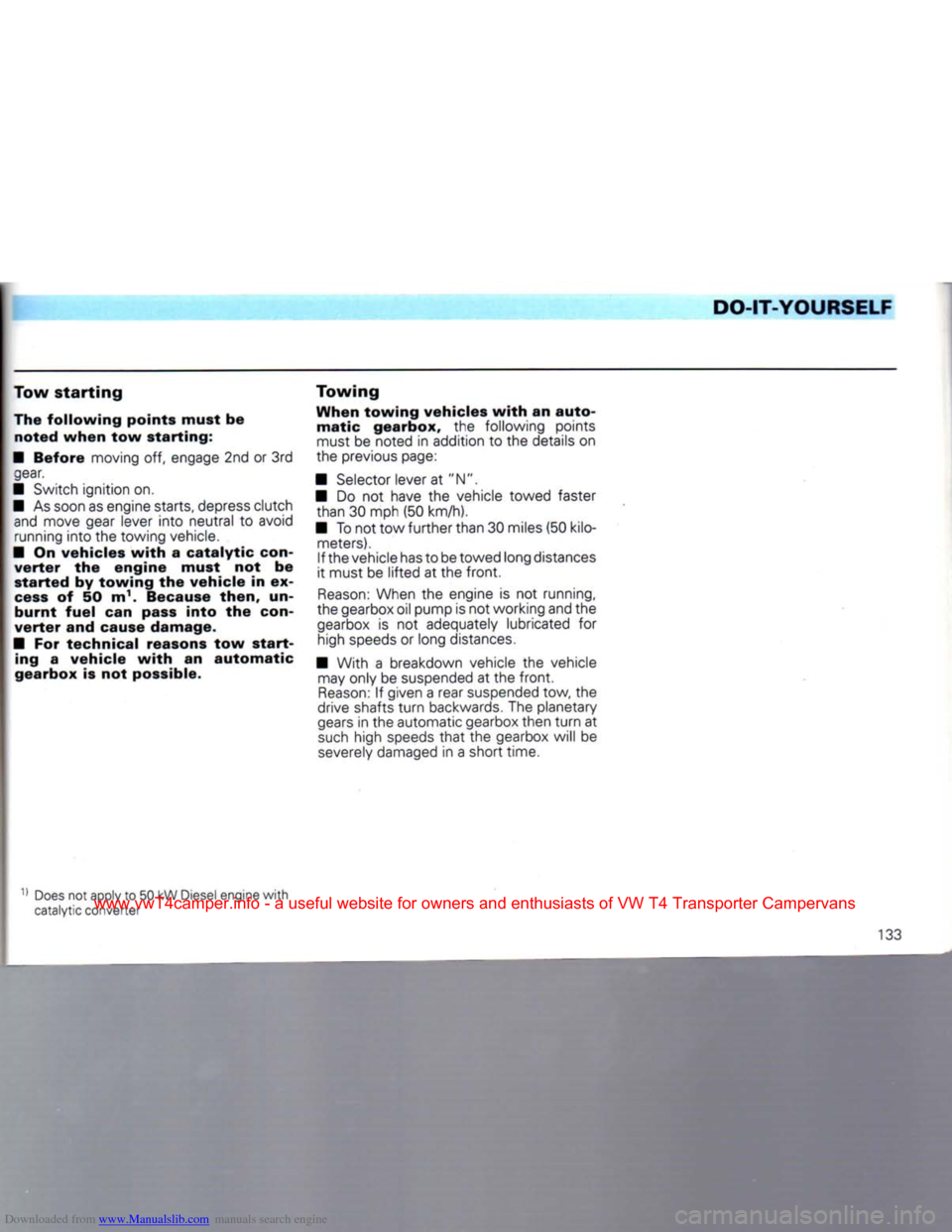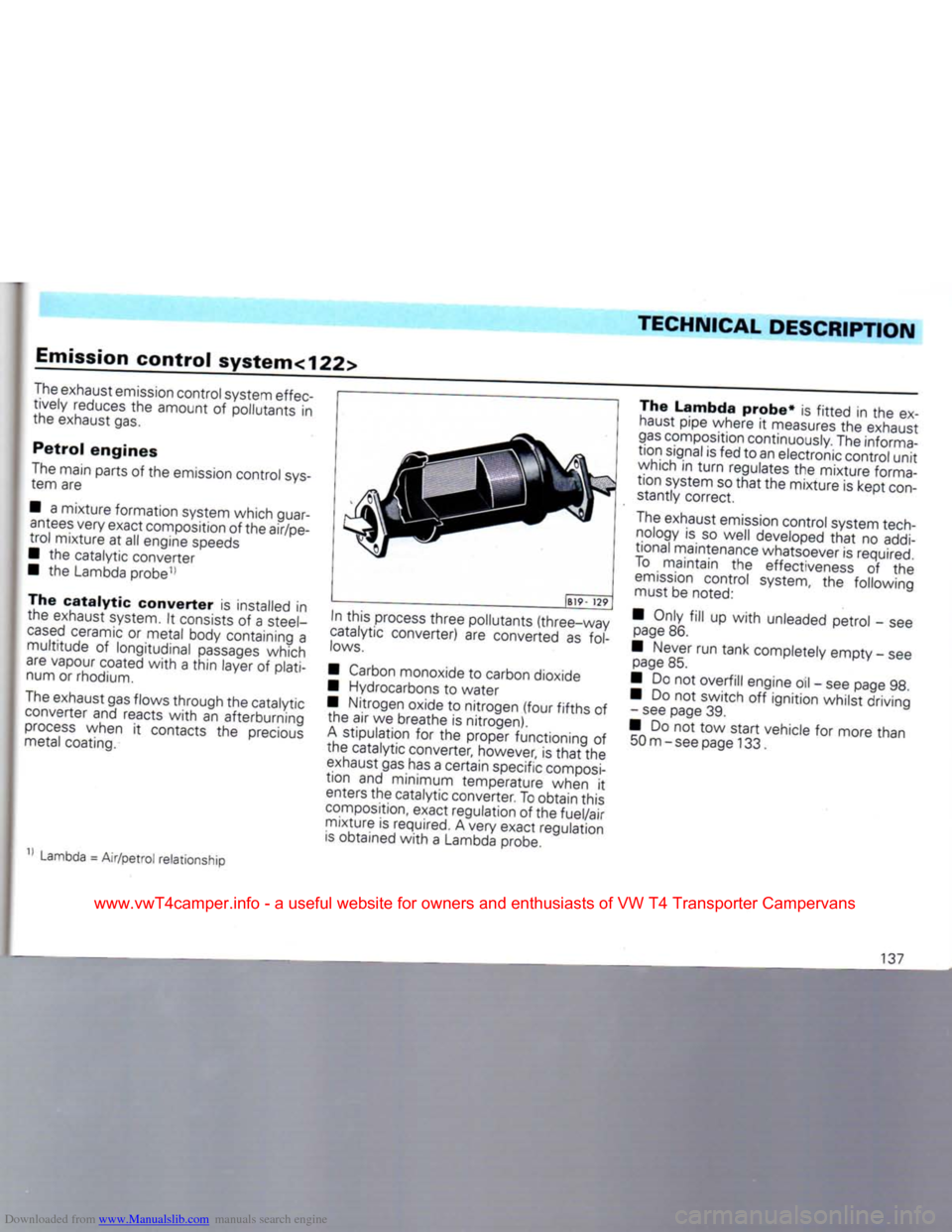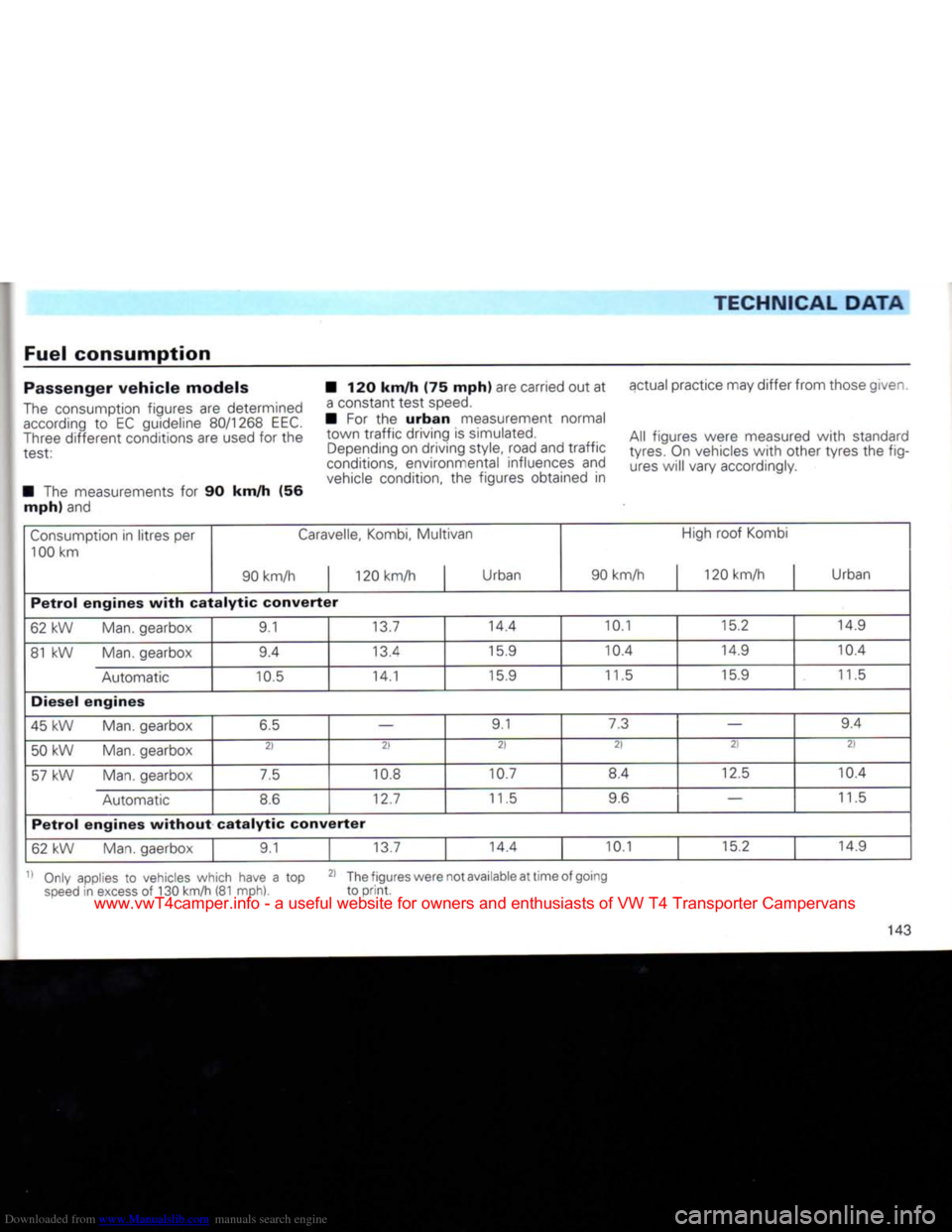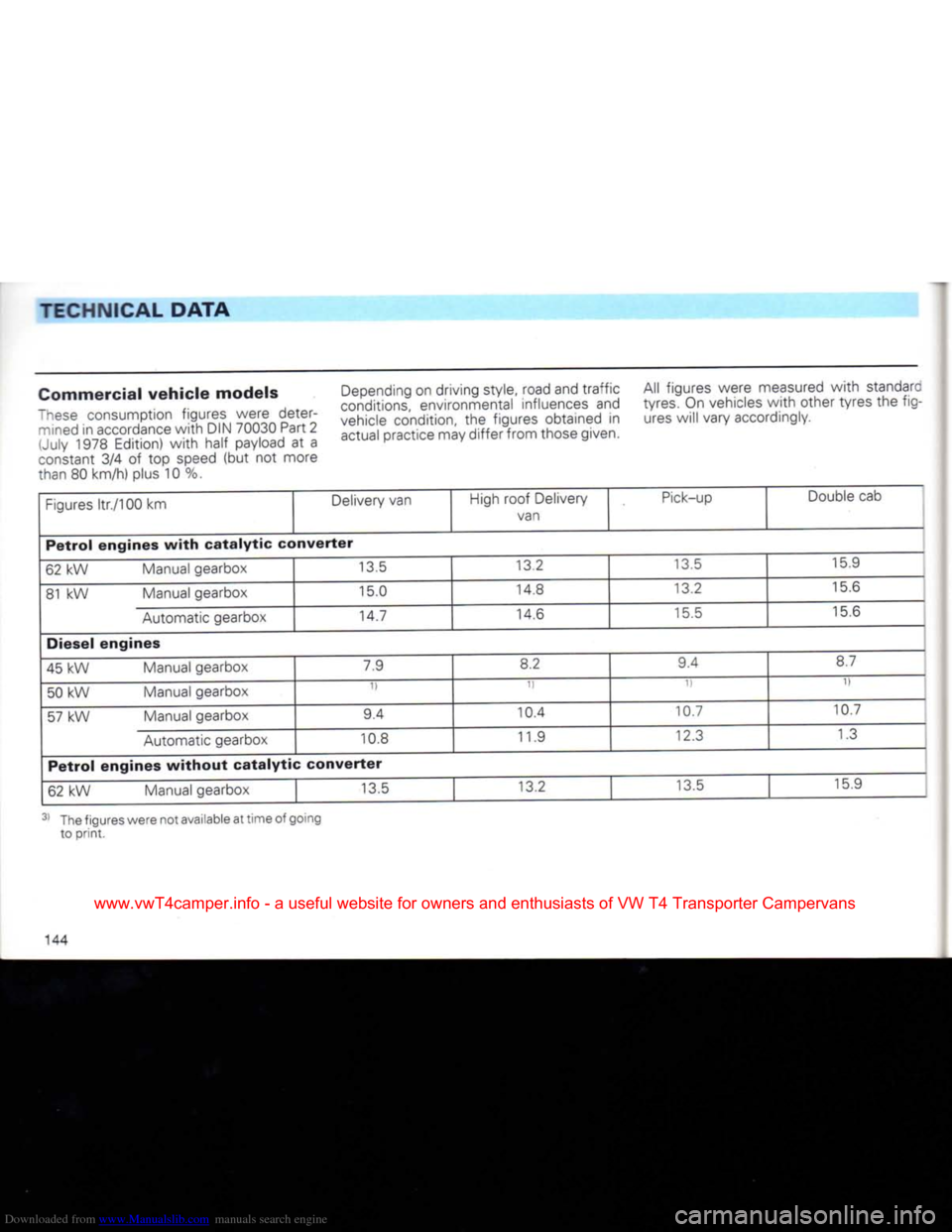1992 VOLKSWAGEN CARAVELLE catalytic converter
[x] Cancel search: catalytic converterPage 135 of 164

Downloaded from www.Manualslib.com manuals search engine
DO-IT-YOURSELF
Tow
starting
The
following
points
must
be
noted
when
tow
starting:
•
Before
moving off, engage 2nd or 3rd gear.
• Switch ignition on.
• As soon as engine starts, depress clutch and move gear lever
into
neutral to avoid running
into
the towing vehicle.
• On
vehicles
with
a
catalytic
con
verter
the
engine
must
not be
started
by
towing
the
vehicle
in ex
cess of 50 m1. Because
then,
un-
burnt
fuel
can pass
into
the con
verter
and cause
damage.
• For
technical
reasons tow
start
ing a
vehicle
with
an
automatic
gearbox
is not possible.
Towing
When
towing
vehicles
with
an
auto
matic
gearbox,
the following points must be noted in addition to the details on
the previous page:
• Selector lever at "N".
• Do not have the vehicle towed faster than 30 mph (50 km/h).
• To not tow
further
than 30 miles (50 kilo meters). If the vehicle has to be towed long distances
it must be
lifted
at the
front.
Reason:
When the engine is not running,
the gearbox oil pump is not working and the
gearbox is not adequately lubricated for high speeds or long distances.
• With a breakdown vehicle the vehicle may only be suspended at the
front.
Reason:
If given a rear suspended tow, the
drive shafts
turn
backwards. The planetary
gears
in the automatic gearbox then
turn
at
such
high speeds
that
the gearbox will be
severely
damaged in a short time.
Does
not apply to 50 kW Diesel engine
with
catalytic converter
133
www.vwT4camper.info - a useful website for owners and enthusiasts of VW T4 Transporter Campervans
Page 139 of 164

Downloaded from www.Manualslib.com manuals search engine
TECHNICAL
DESCRIPTION
Emission
control
system<122>
The exhaust emission control system effec
tively reduces
the
amount
of
pollutants
in
the exhaust gas.
Petrol
engines
The main parts
of the
emission control
sys
tem
are
•
a
mixture formation system which guar antees very exact composition
of
the air/pe
trol
mixture
at all
engine speeds
•
the
catalytic converter
•
the
Lambda probe1'
The
catalytic
converter
is
installed
in
the exhaust system.
It
consists
of a
steel-
cased
ceramic
or
metal body containing
a
multitude
of
longitudinal
passages
which
are vapour coated
with
a
thin
layer
of
plati
num
or
rhodium.
The exhaust gas flows through
the
catalytic converter
and
reacts
with
an
afterburning
process
when
it
contacts
the
precious
metal coating.
Lambda
=
Air/petrol relationship
)B19-
129
In
this process three pollutants (three-way
catalytic converter)
are
converted
as
fol
lows.
• Carbon monoxide
to
carbon dioxide
• Hydrocarbons
to
water
• Nitrogen oxide
to
nitrogen
(four
fifths
of
the
air we
breathe
is
nitrogen).
A
stipulation
for the
proper functioning
of
the catalytic converter, however,
is
that
the
exhaust gas has
a
certain specific composi
tion
and
minimum temperature when
it
enters
the
catalytic converter. To obtain this
composition, exact regulation
of the
fuel/air mixture
is
required. Avery exact regulation
is
obtained
with
a
Lambda probe. The Lambda
probe*
is
fitted
in the ex
haust pipe where
it
measures
the
exhaust
gas
composition continuously. The informa
tion
signal
is
fed
to
an electronic control
unit
which
in
turn
regulates
the
mixture forma
tion
system so
that
the
mixture
is
kept
con
stantly correct.
The exhaust emission control system tech nology
is so
well developed
that
no
addi
tional maintenance whatsoever
is
required.
To
maintain
the
effectiveness
of the
emission
control system,
the
following
must
be
noted:
• Only
fill
up
with
unleaded petrol
- see
page
86.
• Never
run
tank completely empty
-
see page
85.
•
Do not
overfill engine
oil -
see page
98.
•
Do not
switch
off
ignition whilst driving - see page
39.
•
Do not tow
start vehicle
for
more than 50 m-see page 133.
137
www.vwT4camper.info - a useful website for owners and enthusiasts of VW T4 Transporter Campervans
Page 140 of 164

Downloaded from www.Manualslib.com manuals search engine
TECHNICAL
DESCRIPTION
Attention
Due to high temperatures which
can occur in the catalytic
con
verter in very unfavourable conditions, the vehicle should not be parked so that the catalyt
ic converter can come into
con
tact with inflammable materials.
If whilst driving, the engine mis
fires, loses power and runs uneven ly,
this
could be due to a fault in the ignition system. In a
case
like this,
unburnt fuel can enter the exhaust
system and then escape to atmos
phere.
Furthermore, the catalytic
converter could become damaged
due to overheating. The vehicle
speed must be reduced immediately
and the defect should be eliminated
at the nearest Volkswagen dealer.
Note
Even
in the
case
of a
perfectly working
ex
haust emission control system there can, under certain engine operating conditions,
be
a
sulphur-type exhaust
smell.
This
depends upon
the
sulphur content
in
the fuel being
used.
Quite often this can
be
remedied
by
select
ing another brand
of
fuel
or,
filling
up
with
unleaded premium petrol.
50
kW
Diesel
engine
An
oxidation catalytic converter
is
fitted
in
the exhaust system
of
this Diesel engine.
It
consists
of
a steel-cased ceramic body
con
taining
a
multitude
of
longitudinal
passages
which are vapour coated
with
platinum. The catalytic converter largely eliminates
the
unpleasant smelling hydrocarbons
and
turns carbon monoxide
into
carbon dioxide.
In addition
an
exhaust
gas
turbocharger
forces
air
into
the
cylinder, causing
the
en
gine
to
operate
with
a high
excess
of
air. The
fuel which is then injected in is so complete ly
burnt,
that
under
full
load soot is no longer
visible
in the
exhaust.
As
the
diesel engine catalytic converter
does
not get
hotter than
a
conventional
ex
haust system, under normal conditions
there
is
nothing special
to be
noted, this
applies
also
to
parking.
The system does
not
require any additional
care
or
maintenance.
Activated
charcoal
filter*
Vehicles
with
a
regulated catalytic
con
verter,
in
Germany
and
other export countries, have
a
fuel system which
in
cludes
an activated charcoal
filter
(petrol vapour accumulator).
The activated charcoal
filter
prevents
the
fuel vapour escaping
into
the
atmosphere.
These
vapours
pass
into
a
container filled
with
activated charcoal and, when
the en
gine
is
stationary they
are
accumulated
in
the activated charcoal. When
the
engine
is
running,
the
container
is
automatically
ventilated
by
opening
a
valve
and the
fuel
vapour
is fed
into
the
engine
for
combus
tion.
The system works completely automati
cally
and
is
maintenance-free.
138
www.vwT4camper.info - a useful website for owners and enthusiasts of VW T4 Transporter Campervans
Page 144 of 164

Downloaded from www.Manualslib.com manuals search engine
TECHNICAL DATA
Performance
Maximum
speed flaps,
very
wide
tyres
etc. which affect the
in
km/h performance.
The performance figures were measured
without the vehicle being fitted with any
equipment
such as air conditioner, mud
Caravelle, Kombi,
Multivan,
Delivery van
Pick-up
High
roof Kombi,
High
roof Delivery van
Double
cab
Petrol
engines
with
catalytic
converter
62 kW Manual gearbox 144 128
137 132
81 kW Manual gearbox 158 142
151 146
Automatic
154
138 147 142
Diesel
engines
45 kW Manual gearbox 128 115
122 117
50 kW Manual gearbox 132 119
126 121
57 kW Manual gearbox 137 124
131 126
Automatic
133 120
127 122
Petrol
engines
without
catalytic
converter
62 kW Manual gearbox 144
128 137
132
www.vwT4camper.info - a useful website for owners and enthusiasts of VW T4 Transporter Campervans
Page 145 of 164

Downloaded from www.Manualslib.com manuals search engine
TECHNICAL DATA
Fuel
consumption
Passenger
vehicle
models
The consumption figures are determined
according to EC guideline 80/1268 EEC.
Three different conditions are used for the
test:
• The measurements for 90 km/h (56 mph) and • 120 km/h (75 mph) are carried out at
a
constant test
speed.
• For the
urban
measurement normal town
traffic
driving is simulated. Depending on driving style, road and
traffic
conditions, environmental influences and
vehicle condition, the figures obtained in actual practice may differ from those given.
All
figures were measured
with
standard
tyres. On vehicles
with
other tyres the fig ures will vary accordingly.
Consumption in litres per 100 km
Caravelle,
Kombi, Multivan
90 km/h 120 km/h Urban 90 km/h High roof Kombi
120 km/h Urban
Petrol
engines
with
catalytic
converter
62 kW Man. gearbox 9.1 13.7
14.4 10.1
15.2 14.9
81 kW Man. gearbox 9.4 13.4 15.9
10.4
14.9 10.4
Automatic
10.5
14.1
15.9
11.5
15.9
11.5
Diesel
engines
45
kW Man. gearbox 6.5
— 9.1
7.3
— 9.4
50 kW Man. gearbox 2)
2) 2)
2)
2!
2)
57 kW Man. gearbox 7.5 10.8 10.7
8.4
12.5
10.4
Automatic 8.6 12.7
11.5
9.6
—
11.5
Petrol
engines
without
catalytic
converter
62 kW Man. gaerbox 9.1
13.7 14.4
10.1 15.2
14.9
Only
applies to vehicles which have a top
speed
in
excess
of 130 km/h (81 mph). 21 The figures were not available at time of going
to
print.
143
www.vwT4camper.info - a useful website for owners and enthusiasts of VW T4 Transporter Campervans
Page 146 of 164

Downloaded from www.Manualslib.com manuals search engine
TECHNICAL DATA
Commercial
vehicle
models
These consumption figures were deter-
Tiined
in accordance with DIN 70030 Part 2
(July 1978 Edition) with half payload at a
constant 3/4 of top speed (but not more
than 80 km/h) plus 10 %. Depending on driving style, road and traffic
conditions, environmental influences and
vehicle condition, the figures obtained in
actual practice may differ from those given. All figures were measured with standarc
tyres.
On vehicles with other tyres the
fig
ures will vary accordingly.
Figures ttr./l 00 km Delivery van
High roof Delivery
van Pick-up
Double cab
Petrol engines with catalytic converter
62 kW Manual gearbox 13.5 13.2
13.5 15.9
81 kW Manual gearbox 15.0 14.8
13.2 15.6
Automatic gearbox 14.7
14.6 15.5 15.6
Diesel engines
45 kW Manual gearbox 7.9 8.2 9.4
8.7
50 kW Manual gearbox ii
D
D
57 kW Manual gearbox 9.4 10.4
10.7 10.7
Automatic gearbox 10.8 11.9
12.3 1.3
Petrol engines without catalytic converter
62 kW Manual gearbox 13.5 13.2
13.5 15.9
31 The figures were not available at time of going to print.
144
www.vwT4camper.info - a useful website for owners and enthusiasts of VW T4 Transporter Campervans